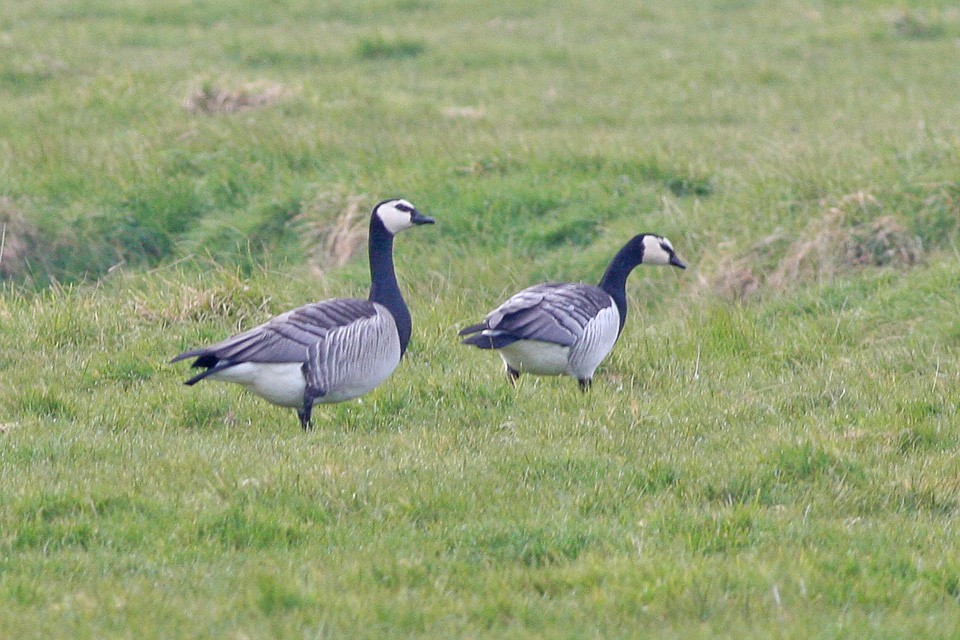Barnacle Goose
A species of Black geese Scientific name : Branta leucopsis Genus : Black geese
Barnacle Goose, A species of Black geese
Botanical name: Branta leucopsis
Genus: Black geese
Content
Description People often ask General Info
Description
The barnacle goose is a medium-sized goose, 55–70 cm (22–28 in) long, with a wingspan of 130–145 cm (51–57 in) and a body mass of 1.21–2.23 kg (2.7–4.9 lb). It has a white face and black head, neck, and upper breast. Its belly is white. The wings and its back are silver-gray with black-and-white bars that look like they are shining when the light reflects on it. During flight, a V-shaped white rump patch and the silver-gray underwing linings are visible. 
Size
58 - 71 cm
Colors
Black
White
Life Expectancy
19 years
Nest Placement
Ground
Feeding Habits
Barnacle Goose, primarily herbivorous, consumes leaves, roots, and tubers. Foraging behavior involves grazing on land or in shallow water. Unique adaptations include a preference for certain types of aquatic vegetation.
Habitat
The barnacle Goose inhabits temperate to polar environments, favoring tundra and wetland ecosystems. During breeding, they nest on Arctic tundra cliffs, with a preference for southern-facing slopes near water. Their summer habitats include polar semi-desert tundra, moss meadows, and mudflats, while wintering grounds comprise lowland meadows, mudflats, and coastal saltmarshes. Different populations exhibit varied winter habitat preferences, from natural saltmarshes to fertilized pastures.
Dite type
Herbivorous
People often ask
General Info
Feeding Habits
Bird food type
Behavior
Barnacle geese frequently build their nests high on mountain cliffs, away from predators (primarily Arctic foxes and polar bears), but also away from their feeding grounds such as lakes, rivers. Like all geese, the goslings are not fed by the adults. Instead of bringing food to the newly hatched goslings, the goslings are brought to the ground. The parents show them the way to jump from the cliff and the goslings follow them by instincts and take the plunge. Unable to fly, the goslings, in their first days of life, jump off the cliff and fall; their small size, feathery down, and very light weight helps to protect some of them from serious injury when they hit the rocks below, but many die from the impact. Arctic foxes are attracted by the noise made by the parent geese during this time, and capture many dead or injured goslings. The foxes also stalk the young as they are led by the parents to wetland feeding areas. Due to these hardships only 50% of the chicks survive the first month. 
Distribution Area
Barnacle geese breed mainly on the Arctic islands of the North Atlantic. The three main populations, with separate breeding and wintering ranges, from west to east, are: Breeding in eastern Greenland, wintering on the Hebrides of western Scotland and in western Ireland, population about 40,000 Breeding on Svalbard, Norway, wintering on the Solway Firth on the England/Scotland border, population about 24,000 Breeding on Novaya Zemlya, Russia, wintering in the Netherlands, population about 130,000 A new fourth population, derived from the Novaya Zemlya population, has become established since 1975 breeding on the islands and coasts of the Baltic Sea (Estonia, Finland, Denmark, and Sweden), and wintering in the Netherlands. Its population numbers about 8,000. Small numbers of feral birds, derived from escapes from zoo collections, also breed in other Northern European countries. Occasionally, a wild bird will appear in the Northeastern United States or Canada, but care must be taken to separate out wild birds from escaped individuals, as barnacle geese are popular waterfowl with collectors. 
Species Status
The barnacle goose is one of the species to which the Agreement on the Conservation of African-Eurasian Migratory Waterbirds applies. According to Sveriges ornitologiska förening, the geese began breeding in Sweden in 1971, and according to Skansen, it was 40 years ago, more or less, when the entire population of barnacle geese left in the autumn to return in spring, soon after they began breeding in the wild. The number of barnacle geese is stable to increasing. 
